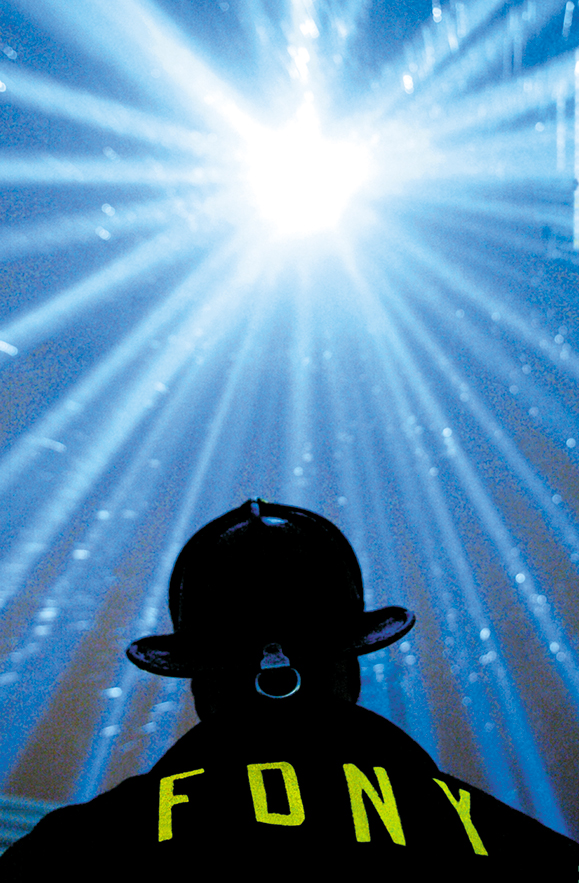“One hundred and fifty years after the Famine, the spirit of the Irish people was the backbone which America relied upon during the worst attack in our nation’s history.”
– Rudy Giuliani at the Irish Famine memorial dedication in New York.
It’s hard to believe it’s only a year. So much has changed, it seems as if it should have taken several lifetimes.
The oddest thing is that people who never wanted to come to New York want to come here now. The myth of the scary New Yorker has been banished. Some visitors want to be part of the experience, to touch the humanity that came out of it; others come to gape at the big hole where the Twin Towers used to be. It’s too bad they didn’t come before, because the view from the top was terrific. No other sight of man-made beauty was ever so awe-inspiring.
Now there’s just a hole and a squabble to decide what to build. What kind of a memorial do you build when a piece of the world dies?
Across the river in Brooklyn, with its view of downtown Manhattan, the most unlikely people have come together to plant a garden in the shape of the towers. We’re tough, we don’t do this sort of thing, one Brooklynite explains, but they do now. New Yorkers showed the world what they were made of.
As Pete Hamill on a recent MSNBC show said, “It’s about being knocked down, but getting up. Because any good story begins when the guy gets up. And this town got up with tenacity and decency and fairly good manners to show that they were not going to stay on the floor. And they got up very quickly.”
On a beautiful day like today it’s easy to forget that anything wrong happened in our city. On my early morning walk, a breeze blows in from the river, a group of police academy plebes get ready for a workout. Their names, printed on the back of grey t-shirts, speak of ancestors who came here from all over the world. One is named Romance. Later as I walk to work, a bird sings somewhere in the trees, a man whistles as he empties his car onto the sidewalk, a woman walks by talking to herself and she’s not on a cell phone. I get my bagel and tea from the Indian man on the corner, it’s still a dollar.
But it’s always there in the back of the mind. It just takes a fire siren, or catching sight of a poster of a missing person, still clinging to a lamppost, to bring it all back.
As an editor I wondered about covering the one year anniversary of September 11. There are those who say we have to move on. But I believe there is the need to remember what terrible life changes have been wrought on so many, and make sure that the families of those who lost someone know that they will not be forgotten.
Lynn Tierney, writing in this issue has found the words to eloquently tell the story of five fathers who went down to Ground Zero in search of their firefighter sons. Though Lynn has left the FDNY, she has a firefighter’s heart and the ability to show the sorrow but also the true caliber of these men.
In this issue also, Dennis Smith offers his opinions on why the towers fell. Though no one could have predicted the possibility of two planes hitting the towers straight on, his is a cautionary tale of the need for stricter fire regulations.
But it’s very difficult to communicate in words what Peter Foley’s photographs capture in images. His cover photograph of a New York City firefighter staring up at the twin beams of light, just moments before they were turned off for the final time, says it all. As do his photographs of the closing ceremony at Ground Zero and memorial services, including one of the final funerals, that of firefighter Tom Butler.
Photographs are powerful documents. Indeed, in another story also in this issue, there is a photograph of three people: Richard Moore, who was blinded at age 10 by a rubber bullet, Clare Gallagher who lost her sight in the Omagh bombing, and Kim Phuc from Vietnam. In a famous 1972 war photo Phuc was a little girl running naked down a road after a napalm attack. This photograph caused such a public outcry that it helped to stop American involvement in Vietnam.
Some day there will be a memorial at Ground Zero. In the meantime, just a couple of block away, there is a memorial to the Irish Famine (see story page 14) that reminds us that “so much that is exquisitely beautiful is wrought from suffering” (Oscar Wilde).
It’s a memorial that speaks of survival, of hope, and it’s a tribute to the courage of our ancestors and the contribution that they have made to America since that first boatload of starving Irish arrived on Manhattan’s shores. As former New York Mayor Rudy Giuliani said at the dedication ceremony: “One hundred and fifty years after the Famine, the spirit of the Irish people was the backbone which America relied upon during the worst attack in our nation’s history.”
It’s one year later and we have seen tremendous changes but we have also been strengthened by the courage and caring of so many. We go on. ♦


Leave a Reply